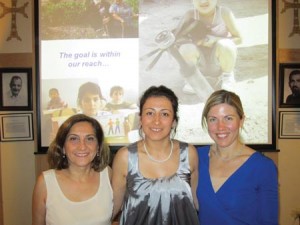Marine Vardanyan
Editor

Photo: Barlow Der Mugrdechian
Imagine stepping outside of your home only to find yourself surrounded by land mines, not knowing if your next step will activate a mine or a cluster bomb. Would you be able to live in such conditions? Citizens of Nagorno-Karabakh are forced into such situations every day, as they exist alongside the remnants of war. However, the process of mine and cluster munition clearance, which has been taking place in the region since the year 2000, brings promise of a future where such danger will no longer exist.
Landmine Free Artsakh is raising community awareness and funds to help HALO in the mineclearance activity in Nagorno-Karabagh. HALO Trust, an American non-profit organization and a British charity dedicated to the removal of the hazardous debris of war. On Tuesday, October 8, 2013, community members learned about this project during a presentation by HALO Trust representative Galina Danilova, held at the Charlie Keyan Armenian Community School. Danilova was accompanied by San Francisco-based HALO Development Manager Amy Curren and by Los Angeles volunteer Ojeni Sammis.
The Nagorno-Karabakh conflict took place almost 20 years ago, yet the people of the region continue to deal with the aftermath, one that is not as obvious, but which still takes lives, maims and injures, and leaves the country in a war-torn condition. Deadly mines and cluster bombs litter the region and many Armenians are in danger, as their means of survival, which includes collecting wood, herbs, and handling livestock, puts them at high risks of encountering explosives.
Danilova screened two videos giving insight on how the explosive devices do not discriminate, creating victims of all ages. The videos evoked an emotional response from the audience, and gave an idea of the extent of damage these mines and bombs cause.
“You’ve seen only two stories, I know 350,” stated Danilova.
Danilova spoke about the munitions that range from large antitank mines the size of big plates, to small cluster bombs that appear harmless to children. Mine clearance has brought benefits such as giving the people of Karabakh employment opportunities, with a national staff of 170. These trained clearance teams work attentively with their detectors to cover every inch of the land. A slow and lengthy process, mine clearance is most effectively executed through this “one man, one lane” method, since the mountainous and rocky terrain prevents any faster means. When coming across a mine or bomb, the team destroys or detonates the item in place.
Mine risk education is also part of the process and it is important to focus on children and teach them about the danger. The minefields have also had a tremendous impact on the economy. Large areas littered with explosives have prevented farmers from utilizing fertile fields. For example, the Fizuli minefield, originally a 650 acre vineyard, has resulted in an estimated $2.5 million dollar a year loss.
“After war, we all like to think that casualties end, but not in Karabakh,” commented Professor Barlow Der Mugrdechian, on the grim reality of the region.
However, Danilova’s presentation on the work by HALO Trust gave hope that the situation in Karabakh will eventually be resolved and that the Armenian people will finally be able to live without the everyday risk of encountering a dangerous explosive.
 Hye Sharzhoom Armenian Action
Hye Sharzhoom Armenian Action